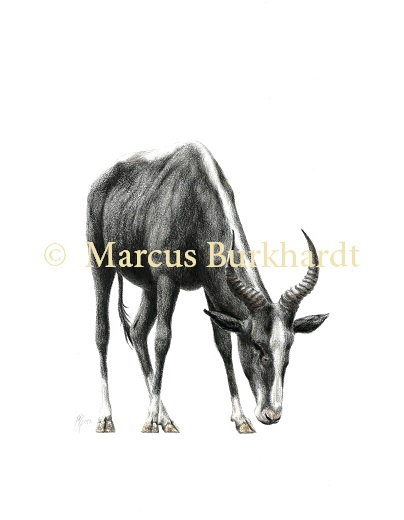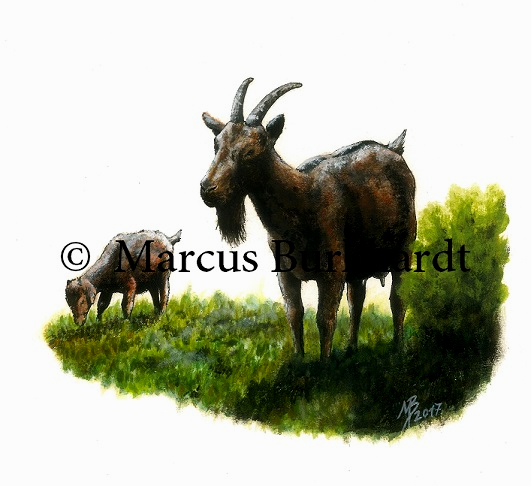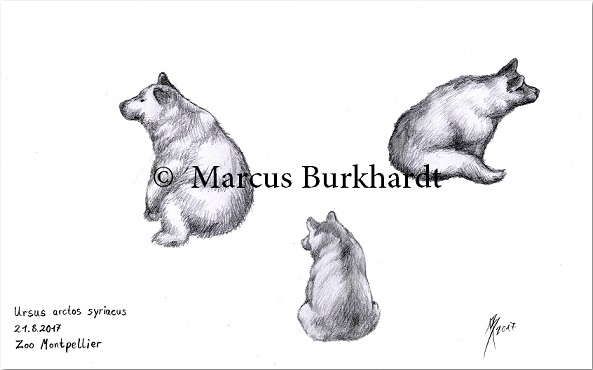
Scimitar-horned oryx (Oryx dammah)
Acrylic & oil paint on canvas, 2020
40 x 30 cm

Scimitar-horned oryx (Oryx dammah)
Acrylic & oil paint on canvas, 2020
40 x 30 cm

Mountain anoa (Bubalus quarlesi)
Pencil, 2020
29,5 x 21 cm

Southern blue wildebeest (Connochaetes taurinus)
Pencil, 2021
30 x 24 cm

Zebra duiker (Cephalophus zebra)
Pencil, 2020
29,5 x 21 cm

Slender horned gazelle (Gazella leptoceros)
Mixed media, 2020
24 x 17 cm

Eurasian Aurochs (Bos primigenius primigenius) with cattle egrets (Bubulcus ibis)
Oil paint on paper, 2018
40 x 30 cm

Saola (Pseudoryx nghetinhensis)
Oil paint on paper, 2020
30 x 24 cm

Thylacine (Thylacinus cynocephalus) & Bennett’s wallaby (Notamacropus rufogriseus fruticus)
The thylacine or Tasmanian tiger was the biggest carnivorous marsupial in historical times and was exterminated around 1900. The last individual died in 1936 at Hobart zoo.
Acrylic- & oil paint on canvas, 2019
40 x 30 cm

Hezhengia bohlini (Antilopinae), Miocene, China
H. bohlini was a species of bovid that was found in the Liushu Formation at the Linxia Basin in China. Most likely it was a mixed feeder doing both grazing and browsing.
Coloured pencil, 2020
32 x 24 cm

Plesiaddax depereti (Urmiatherini), Miocene, Eurasia
The Urmiatherini, which are close related to modern goat-antelopes (Caprini), are an extinct group of very diverse-looking bovids. One genus of them was Plesiaddax, which had horns different from any today’s forms, but a body similar to extant wildebeests (Connochaetes). According to this it was a resident of more open habitats, where it fed mostly on grass.
Coloured pencil, 2020
30 x 24 cm

Thaleroceros radiciformis, Lower – Middle Pleistocene, East Africa
This antelope is probably a member of the reedbuck-relatives (Reduncini). This is supposed on account of the direction of the horns and the presence of a second pair of horns. This feature is sometimes visible in modern reedbucks. According to Prof. Dr. Hans Reck (1886-1937), who described the fossil, this second pair of horns were not covered by keratin. Because of the scarce remains, which show not much more than the impressive horns, its systematic position remains unclear.
Coloured pencil, 2020
32 x 24 cm

Stoat (Mustela erminea) in winter fur
Oil paint on canvas, 2019
40 x 30 cm
The picture originated during the symposium “Kunst am Berg”, Panoramarestaurant BergDiamant Fiss/Austria.

Alpine chamois (Rupicapra rupicapra rupicapra)
Oil paint on canvas, 2019
40 x 30 cm
The picture originated during the symposium “Kunst am Berg”, Panoramarestaurant BergDiamant Fiss/Austria.

Alpine marmots (Marmota marmota)
Oil paint on panel, 2019
40 x 30 cm
The picture originated during the symposium “Kunst am Berg”, Panoramarestaurant BergDiamant Fiss/Austria.

Alpine ibex (Capra ibex)
Oil paint on panel, 2019
40 x 30 cm
The picture originated during the symposium “Kunst am Berg”, Panoramarestaurant BergDiamant Fiss/Austria.

Summary of all fossil Alcelaphini-genera with selected species
Coloured pencil drawings, digitally composed; 2018
The reconstructions were made with kindly support by paleontologist Dr. Faysal Bibi from the Museum for Natural History Berlin.
 .
.
Menelikia lyrocera (Bovidae), Pliocene – Pleistocene, East Africa
This medium-sized antelope had horns with transverse ridges and was possibly similar to today’s Nile lechwe / Mrs Gray’s lechwe (Kobus megaceros) in its ecology.
Pencil, 2019
29,5 x 21 cm
The picture was drawn from two exhibits at the National Museum of Natural History (MNHN) in Paris.

Numidocapra crassicornis (Bovidae), Early Pleistocene, North- and East Africa
Fossils of this widespread species were found in Ethiopia, Djibouti and Algeria. Temporary it was placed in Caprinae. A special feature are the horns that curve foreward in side view. The name means “goat from Numidia”, an ancient kingdom in North Africa.
Coloured pencil, 2018
30 x 24 cm

Awashia suwai (Bovidae), Late Pliocene, Ethiopia
A. suwai was found at the Matabaietu formation which is located at the eponymous river Awash in Ethiopia. It lived there about 2,5 million years ago together with hominids like Australopithecus garhi and maybe Paranthropus aethiopicus.
Coloured pencil, 2018
30 x 24 cm

Damalops palaeindicus (Bovidae), Late Pliocene, South Asia
This is a notably species in two aspects: on the one hand it is the only known alcelaphine outside of Africa, on the other hand its horn form is very simple compared to other Alcelaphini. D. palaeindicus lived during the Pinjor formation about 2,5 million years ago in the area of today’s Siwaliks (southern Himalayas) in India. There are also remains from the Republic of Tajikistan.
Coloured pencil, 2018
30 x 24 cm

Parmularius maasaicus (Bovidae); Pleistocene, East Africa
A medium-sized alcelaphine which was only found at Olduvai Gorge. I could be an ancestor of the extant hartebeests (Alcelaphus). It was named in honor of the Maasai people who live in the Olduvai Gorge area.
Coloured pencil, 2018
30 x 24 cm

Megalotragus kattwinkeli (Bovidae), Pleistocene, East Africa
M. kattwinkeli is with expected 250 kg one of the biggest alcelaphines and closely related to the modern wildebeest. The horn cores vary a lot in this species, from a more compressed type with their tips curving inwards in smaller specimens to a more elongated type in bigger individuals. There is also a tendency to a domed skull with hollows, but not as distinct like that in Megalotragus atopocranion. The locality of M. kattwinkeli is the famous Olduvai Gorge in northern Tanzania. Here it occured with Paranthropus boisei, Homo habilis and Homo erectus. It was named after the German paleontologist and neurologist Wilhelm Kattwinkel (1866 – 1935).
Coloured pencil, 2018
30 x 24 cm

Megalotragus atopocranion (Bovidae), Late Pleistocene, East Africa
This is the most popular of fossil alcelaphines because of a unique feature in mammals: a domed skull with hollows and air passages, which probably were used for infrasonic communication with fellows. M. atopocranion was a grazer, which was possibly hunted by modern man (Homo sapiens). It is better known under its synonym Rusingoryx atopocranion, named after its location Rusinga Island at Lake Victoria.
Coloured pencil, 2018
30 x 24 cm

Damalborea elisabethae (Bovidae), Middle Pliocene, East Africa
This prehistoric alcelaphine was discovered at the Hadar-Formation in Ethiopia. It lived there about 3,3 million years ago together amongst others with the hominin Australopithecus afarensis. It was named after paleontologist Elisabeth Vrba.
Coloured pencil, 2018
30 x 24 cm

Damalacra neanica (Bovidae), Early Pliocene, South Africa
An alcelaphine that lived about 5,3 – 3,6 million years ago. Probably their feeding niches range from browsers to mixed feeders. D. neanica was about as large as today’s blesbok (Damaliscus pygargus phillipsi).
Coloured pencil, 2018
30 x 24 cm

Dorcas gazelle (Gazella dorcas)
Pencil, 2018
21 x 15 cm
The picture was drawn from a zoological specimen at the natural history museum in Waldenburg.

Ringed waterbuck (Kobus ellipsiprymnus)
Pencil, 2018
21 x 15 cm
The picture was drawn from a zoological specimen at the natural history museum in Waldenburg.

Lelwel Hartebeest (Alcelaphus lelwel), signposted at the museum as Lichtenstein’s hartebeest (Alcelaphus lichtensteinii), which is impossible because of the horn shape.
Pencil, 2018
29,5 x 21 cm
The picture was drawn from a zoological specimen at the natural history museum in Waldenburg.

Cows on meadow
Oil paint on paper, 2018
40 x 30 cm
Private mission

Sanga cattle
Ink, 2018
29,5 x 21 cm

Domestic yaks (Bos grunniens)
Ink, 2017
42 x 29,5 cm

Domestic goats (Capra aegagrus hircus)
Acrylic paint on paper, 2017
32 x 24 cm
Client: Hotel “Fernmühle” in Ziegenrück

Sketches of Syrian brown bears (Ursus arctos syriacus)
Pencil, 2017
29,5 x 21 cm
The picture originated during an educational jurney to the South of France at the zoo of Montpellier.

Sketch of a domestic rabbit (Oryctolagus cuniculus domestica)
Pencil, 2017
29,5 x 21 cm

Cow on meadow
Oil paint on paper, 2017
32 x 24 cm

Common cattle (Bos primigenius taurus)
Coloured pencil, 2015
29,5 x 21 cm
Private mission
